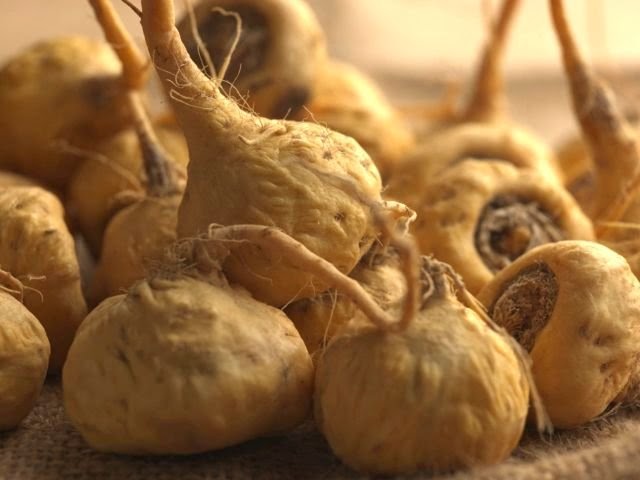Lepidium meyenii or maca is an herbaceous biennial plant or annual plant (some sources say a perennial plant) native to the high Andes of Bolivia and Peru. It is grown for its fleshy hypocotyl (actually a fused hypocotyl and taproot), which is used as a root vegetable and a medicinal herb. Its Spanish and Quechua names include maca-maca, maino, ayak chichira, and ayak willku.
The growth habit, size, and proportions of the maca are roughly similar to those of the radish and the turnip, to which it is related. The stem is short and lies along the ground, with only the tips curling up. The frilly leaves are born in a rosette at the soil surface, and are continuously renewed from the center as the outer leaves die. The off-white, self-fertile flowers are born on a central raceme, and are followed by 4-5 mm siliculate fruits, each containing two small (2-2.5 mm) reddish-gray ovoid seeds. The seeds, which are the plant's only means of reproduction, germinate within five days, given good conditions, and have no dormancy.
Maca is the only member of its genus with a fleshy hypocotyl, which is fused with the taproot to form a radish- or inverted-pear-shaped body roughly 10-15 cm long and 3-5 cm wide.
Maca is traditionally grown at altitudes of approximately 3,750-4,350 m (12,500-14,500 ft). It grows well only in very cold climates with relatively poor soil. Although it has been cultivated outside the Andes it is not yet clear that it has the same constituents or potency when this is done. Hypocotyls do not form in greenhouses or in warm climates.
For approximately 2000 years maca has been an important traditional food and medicinal plant in its growing region. It is regarded as a highly nutritious food and as a medicine that enhances strength and endurance and also acts as an aphrodisiac. Maca roots are eaten in various ways locally. It can be roasted or boiled in water to form a sweet dish. The dried roots can be mixed with milk to make porridge, or used as flour for baking. If fermented, a weak beer called “chicha de maca” can be produced. The leaves can be eaten as a vegetable, or as a salad, and taste similar to cress.
In addition to sugars and proteins, maca contains uridine, malic acid and its benzoyl derivative, and the glucosinolates, glucotropaeolin and m-methoxyglucotropaeolin. The methanol extract of maca tuber also contained (1R, 3S)-1-methyltetrahydro--carboline-3-carboxylic acid, a molecule which is reported to exert many activities on the central nervous system. The nutritional value of dried maca root is high, similar to cereal grains such as rice and wheat. It contains 60% carbohydrates, 10% protein, 8.5% dietary fiber, and 2.2% fats. Maca is rich in essential minerals, especially selenium, calcium, magnesium, and iron, and includes fatty acids including linolenic acid, palmitic acid, oleic acids, and 19 amino acids, as well as polysaccharides. Maca's reported beneficial effects for sexual function could be due to its high concentration of proteins and vital nutrients, though maca contains a chemical called p-methoxybenzyl isothiocyanate, which reputedly has aphrodisiac properties.
Small-scale clinical trials performed in men have shown that maca extracts can heighten libido and improve semen quality, though no studies have been performed on men with sexual dysfunction or infertility. Maca has not been shown to affect sex hormone levels in humans. In addition, maca has been shown to increase mating behavior in male mice and rats.
Maca works as an adaptogen, instigating the production of certain minerals essential to health, and analysis reveals a brain-powering profile of amino acids, minerals, sterols, and fatty acids. Because Maca is a vegetable rather than a medicine, it can safely be eaten in any quantity by men and women of any age group.
In Peruvian herbal medicine, the maca root is reported to be used as an immuno-stimulant, for anemia, tuberculosis, menstrual disorders, menopause symptoms, stomach cancer, sterility (as well as other reproductive and sexual disorders), and to enhance memory.
Maca has been known to be beneficial for:
- Energy - by balancing the endocrine system - thyroid, pituitary, pancreas and adrenal glands.
- Wellbeing, vitality, emotional balance and stamina
- Change of life discomfort such as hot flushes, breast tenderness, sleeplessness, mood swings and brain fog.
- Low Libido - Maca's aphrodisiac qualities increase sex drive and may relieve other low libido effects like decreased vaginal lubrication.
- General menstrual irregularity - it is well known that menstrual irregularity, like short and long cycles, too little or too much bleeding, spotting, pain etc. can stem from poor nutritional absorption ie, Vit B6, magnesium, EFA's, which in turn upsets the body's delicate hormonal system. As Maca is a whole food organically grown it retains maximum nutritional value, unlike many of the foods on the supermarket or green grocer’s shelf.
- Healthy Fertility - Pregnancy demands extra nutrients for a healthy baby. Unfortunately, many of today's women are overworked, stressed and/or have a long history of taking the Birth Control Pill find that their fertility is compromised. Eating Maca Powder can be an affordable, excellent nutritional addition to every woman’s diet. Peruvian women start to take maca at the age of three, then gradually include it as a staple part of their diet. They are fertile well into later life.













0 comments :
Post a Comment